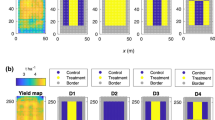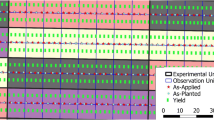Abstract
Precision agriculture (PA) offers opportunities for the development of new approaches to on-farm experimentation to assist farmers with site-specific management decisions. Traditional agricultural experiments are usually implemented in fields with the least possible soil heterogeneity under the assumption that responses to inputs and inherent variation of the soil are additive components of yield variation. However, because the soil in typical fields is not homogeneous, PA has much to offer. Farmers faced with variable conditions need to optimize their management to the variation over space and time on their farm, a problem that is not solved by conventional approaches to experimentation. New designs for on-farm experiments were developed in the 1990s for cereal production in which the whole field was used for the experiment rather than small plots. We explore the extension of this type of experiment to a vineyard in the Clare Valley of South Australia aiming to evaluate options to increase grape yield and vine vigour. Manually sampled indices of vine performance measured on georeferenced ‘target’ grapevines were analysed geostatistically. The major advantage of such an approach is that the spatial variation in response to experimental treatments can be examined. Linear models of coregionalization, pseudo cross-variograms and standardized ordinary cokriging are used to map treatment responses over the experimental area and also the differences between them. The results indicate that both treatment responses and the significance of differences between them are spatially variable. Thus, we conclude that whole-of-block on-farm trials are useful in vineyards.





Similar content being viewed by others
Notes
Here, and throughout this paper, we use the term ‘management unit’ to denote that portion of a farm or field that receives the same management treatment (e.g. fertilizer or irrigation rate, tillage or canopy management). Under conventional management (non-PA), the management unit will typically be a whole field and sometimes may be the whole farm.
References
Adams, M. L., & Cook, S. E. (1997). Methods of on-farm experimentation using precision agriculture technology. In 1997 ASAE annual international meeting (paper No. 97-30-20). St. Joseph, Michigan: ASAE.
Adams, M. L., & Cook, S. E. (2000). On-farm experimentation: Application of different analytical techniques for interpretation. In P. C. Robert, R. H. Rust, & W. E. Larson (Eds.), Proceedings of the fifth international conference on precision agriculture (pp. 1–17). Madison, Wisconsin: ASA-CSSA-SSSA.
Bishop, T. F. A., & Lark, R. M. (2006). The geostatistical analysis of experiments at the landscape-scale. Geoderma, 133, 87–106.
Bishop, T. F. A., & Lark, R. M. (2007). A landscape-scale experiment on the changes in available potassium over a winter wheat cropping season. Geoderma, 141, 384–396.
Bishop, T. F. A., & Lark, R. M. (2008). Reply to “Standardized vs. customary ordinary cokriging…” by Papritz. Geoderma, 146, 397–399.
Bramley, R. G. V. (2003). Precision viticulture—Tools to optimize winegrape production in a difficult landscape. In P. C. Robert (Ed.), Proceedings of the 6th international conference on precision agriculture and other precision resources management, Minneapolis, Minnesota, USA, 14–17 July 2002. (pp. 648–657). Madison, Wisconsin: ASA-CSSA-SSSA.
Bramley, R. G. V. (2005). Understanding variability in winegrape production systems—2. Within vineyard variation in quality over several vintages. Australian Journal of Grape and Wine Research, 11, 33–42.
Bramley, R., Cook, S., Adams, M., & Corner, R. (1999). Designing your own on-farm experiments: How precision agriculture can help. Kingston, Australia: Grains Research and Development Corporation.
Bramley, R. G. V., & Hamilton, R. P. (2004). Understanding variability in winegrape production systems: 1. Within vineyard variation in yield over several years. Australian Journal of Grape and Wine Research, 10, 32–45.
Bramley, R. G. V., Lanyon, D. M., & Panten, K. (2005a). Whole-of-vineyard experimentation—An improved basis for knowledge generation and decision making. In J. V. Stafford (Ed.), Precision agriculture ‘05 (pp. 883–890). Wageningen, The Netherlands: Wageningen Academic Publishers.
Bramley, R. G. V., Proffitt, A. P. B., Hinze, C. J., Pearse, B., & Hamilton, R. P. (2005b). Generating benefits from precision viticulture through selective harvesting. In J. V. Stafford (Ed.), Precision agriculture ‘05 (pp. 891–898). Wageningen, The Netherlands: Wageningen Academic Publishers.
Bramley, R. G. V., & Williams, S. K. (2001). A protocol for the construction of yield maps from data collected using commercially available grape yield monitors. Resource document. Cooperative Research Centre for Viticulture. http://www.crcv.com.au/research/programs/one/CRCVProtocolBkfinal.pdf. Accessed 24 Apr 2009.
Brys, G., Hubert, M., & Struyf, A. (2003). A comparison of some new measures of skewness. In R. Dutter, P. Filzmoser, U. Gather, & P. J. Rousseeuw (Eds.), ICORS 2001, developments in robust statistics (pp. 98–113). Heidelberg, Germany: Springer.
Brys, G., Hubert, M., & Struyf, A. (2004). A robust measure of skewness. Journal of Computational and Graphical Statistics, 13, 996–1017.
Cook, S. E., Adams, M. L., & Corner, R. J. (1999). On-farm experimentation to determine site-specific responses to variable inputs. In P. C. Robert, R. H. Rust, & W. E. Larson (Eds.), Proceedings of the 4th international conference on precision agriculture, St Paul, Minnesota, USA, 19–22 July 1998’ (pp. 611–621). Madison, Wisconsin: ASA-CSSA-SSSA.
Cupitt, J., & Whelan, B. M. (2001). Determining potential within-field crop management zones. In G. Grenier & S. Blackmore (Eds.), Precision agriculture ‘01 (pp. 7–12). Monpellier, France: Agro Montpellier, Ecole National Supérieure Agronomique de Montpellier.
Doerge, T. A., & Gardner, D. L. (1999). On-farm testing using the adjacent strip comparison method. In P. C. Robert, R. H. Rust, & W. E. Larson (Eds.), Proceedings of the 4th international conference on precision agriculture, St Paul, Minnesota, USA, 19–22 July 1998’ (pp. 603–609). Madison, Wisconsin: ASA-CSSA-SSSA.
Dunn, G. M., Martin, S. R., & Petrie, P. R. (2005). Managing yield variation in vineyards. In R. Blair, P. Williams, & S. Pretorius (Eds.), Proceedings of the twelfth Australian wine industry technical conference (pp. 51–56). Urrbrae, South Australia, Australia: Australian Wine Industry Technical Conference Inc.
Fisher, R. A. (1949). The design of experiments. Edinburgh, London, UK: Oliver and Boyd.
Gomez, K. A., & Gomez, A. A. (1984). Statistical procedures for agricultural research. New York, USA: Wiley.
Journel, A. G., & Huijbregts, C. J. (1978). Mining geostatistics. London, UK: Academic Press.
Lanyon, D. M., & Bramley, R. G. V. (2006). Investigating a soil management option to overcome salinity problems through whole-of-block experimentation. The Australian & New Zealand Grapegrower & Winemaker, 512, 19–24.
Lark, R. M. (2000). A comparison of some robust estimators of the variogram for use in soil survey. European Journal of Soil Science, 51, 137–157.
Lark, R. M. (2002). Modelling complex soil properties as contaminated regionalized variables. Geoderma, 106, 173–190.
Lark, R. M., Bellamy, P. H., & Rawlins, B. G. (2006). Spatio-temporal variability of some metal concentrations in the soil of eastern England, and implications for soil monitoring. Geoderma, 133, 363–379.
Lark, R. M., & Papritz, A. (2003). Fitting a linear model of coregionalization for soil properties using simulated annealing. Geoderma, 115, 245–260.
Lark, R. M., & Wheeler, H. C. (2003). A method to investigate within-field variation of the response of combinable crops to an input. Agronomy Journal, 95, 1093–1104.
McBratney, A. B., Mendonça Santos, M. L., & Minasny, B. (2003). On digital soil mapping. Geoderma, 117, 3–52.
Minasny, B., McBratney, A. B., & Whelan, B. M. (2005). VESPER Version 1.62. Resource Document. Australian Centre for Precision Agriculture, McMillan Building A05, the University of Sydney, NSW. http://www.usyd.edu.au/su/agri/acpa/. Accessed 24 Apr 2009.
Papritz, A. (2008a). Standardized vs. customary ordinary cokriging: Some comments on the article “The geostatistical analysis of experiments at the landscape-scale” by T. F. A. Bishop and R. M. Lark. Geoderma, 146, 391–396.
Papritz, A. (2008b). Rejoinder to the reply to “Standardized vs. customary ordinary cokriging…” by T. F. A. Bishop and R. M. Lark. Geoderma, 148, 121–122.
Papritz, A., Künsch, H. R., & Webster, R. (1993). On the pseudo cross variogram. Mathematical Geology, 25, 1015–1026.
Petersen, R. G. (1994). Agricultural field experiments. Design and analysis. New York, USA: Marcel Dekker Inc.
Pringle, M. J., Cook, S. E., & McBratney, A. B. (2004a). Field-scale experiments for site-specific crop management. Part I: Design considerations. Precision Agriculture, 5, 617–624.
Pringle, M. J., McBratney, A. B., & Cook, S. E. (1999). Some methods of estimating yield response to a spatially-varied input. In J. V. Stafford (Ed.), Precision agriculture ‘99 (pp. 309–318). Sheffield, UK: Sheffield Academic Press.
Pringle, M. J., McBratney, A. B., & Cook, S. E. (2004b). Field-scale experiments for site-specific crop management. Part II: A geostatistical analysis. Precision Agriculture, 5, 625–645.
Smith, H. F. (1938). An empirical law describing heterogeneity in the yields of agricultural crops. Journal of Agricultural Science, 28, 1–23.
Walker, R. R., Blackmore, D. H., Clingeleffer, P. R., Kerridge, G. H., Ruhl, E. H., & Nicholas, P. R. (2005). Shiraz berry size in relation to seed number and implications for juice and wine composition. Australian Journal of Grape and Wine Research, 11, 2–8.
Webster, R., & Oliver, M. A. (2007). Geostatistics for environmental scientists. Chichester: Wiley & Sons.
Acknowledgments
This work was funded by CSIRO Sustainable Ecosystems, Foster’s Wine Estates, the Commonwealth Cooperative Research Centres Program under the auspices of the Cooperative Research Centre for Viticulture (CRCV) and Australia’s grapegrowers and winemakers through their investment body the Grape and Wine Research and Development Corporation. We are most grateful to Jackie Ouzman and David Gobbett for their excellent technical assistance, to Dr Dean Lanyon for his ongoing willingness to discuss ideas, and to the staff and management of Foster’s Wine Estates in Clare without whose support the work would not have been possible. In particular, the input of John Matz, Colin Hinze (now with Taylors Wines) and Dr Richard Hamilton has been valued greatly. The original codes used in this analysis were developed at Rothamsted by T.F.A. Bishop in research funded by the UK Biotechnology and Biological Sciences Research Council (BBSRC), project D20191. R. M. Lark’s contribution is part of Rothamsted Research’s programme in Computational and Mathematical Biology, funded by the BBSRC.
Author information
Authors and Affiliations
Corresponding author
Rights and permissions
About this article
Cite this article
Panten, K., Bramley, R.G.V., Lark, R.M. et al. Enhancing the value of field experimentation through whole-of-block designs. Precision Agric 11, 198–213 (2010). https://doi.org/10.1007/s11119-009-9128-y
Received:
Accepted:
Published:
Issue Date:
DOI: https://doi.org/10.1007/s11119-009-9128-y




